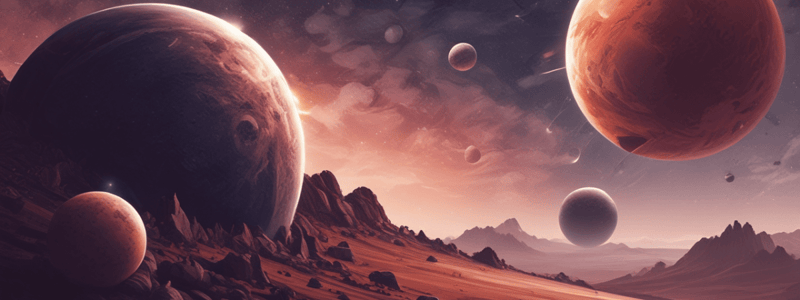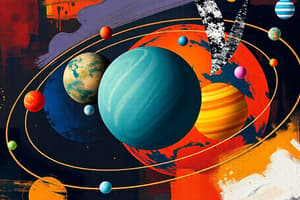Podcast
Questions and Answers
Which of the following characteristics disqualifies Pluto from being classified as a planet?
Which of the following characteristics disqualifies Pluto from being classified as a planet?
- It has not cleared its orbital path. (correct)
- It has a very long orbital period.
- It has a small radius compared to other objects.
- It is located in the asteroid belt.
Which of the following dwarf planets is located in the asteroid belt?
Which of the following dwarf planets is located in the asteroid belt?
- Ceres (correct)
- Eris
- Haumea
- Pluto
What is the approximate radius of Ceres?
What is the approximate radius of Ceres?
- 715 miles (1,151 km)
- 2,500 miles (4,023 km)
- 3,200 miles (5,149 km)
- 296 miles (476 km) (correct)
What is the average distance of Pluto from the Sun?
What is the average distance of Pluto from the Sun?
Which dwarf planet was the first to be visited by a spacecraft?
Which dwarf planet was the first to be visited by a spacecraft?
What is the primary reason for classifying Eris as a dwarf planet?
What is the primary reason for classifying Eris as a dwarf planet?
Which characteristic distinguishes Eris from Pluto?
Which characteristic distinguishes Eris from Pluto?
What is the approximate average distance of Eris from the Sun?
What is the approximate average distance of Eris from the Sun?
How long does it take Eris to complete one orbit around the Sun?
How long does it take Eris to complete one orbit around the Sun?
What happens to Eris's atmosphere as it moves closer to the Sun?
What happens to Eris's atmosphere as it moves closer to the Sun?
What significant feature does Haumea possess that differentiates it from other known dwarf planets?
What significant feature does Haumea possess that differentiates it from other known dwarf planets?
How does Makemake's density compare to that of Haumea?
How does Makemake's density compare to that of Haumea?
Which of the following correctly identifies the moons of Haumea?
Which of the following correctly identifies the moons of Haumea?
What is the approximate distance of Makemake from the Sun?
What is the approximate distance of Makemake from the Sun?
What factor contributed to the reclassification of Pluto and the introduction of the dwarf planet category?
What factor contributed to the reclassification of Pluto and the introduction of the dwarf planet category?
What characteristic must a celestial body fulfill to be classified as a planet?
What characteristic must a celestial body fulfill to be classified as a planet?
Which of the following celestial bodies was originally classified as a planet before being redefined as a dwarf planet?
Which of the following celestial bodies was originally classified as a planet before being redefined as a dwarf planet?
What is the primary criteria that distinguishes a dwarf planet from a regular planet?
What is the primary criteria that distinguishes a dwarf planet from a regular planet?
Which of the following materials is Ceres primarily composed of?
Which of the following materials is Ceres primarily composed of?
What significant change occurred in the classification of solar system bodies in 2006?
What significant change occurred in the classification of solar system bodies in 2006?
Flashcards are hidden until you start studying
Study Notes
Definition and Classification
- Planets orbit the Sun and clear their orbital path, while dwarf planets do not fully meet this criterion.
- Dwarf planets are smaller than regular planets but still large and round.
- The International Astronomical Union (IAU) established a three-tier classification in 2006: planets, dwarf planets, and asteroids.
- Initial dwarf planets recognized were Pluto, Ceres, and Eris, with Makemake and Haumea added in 2008.
Dwarf Planets Overview
- Currently, five recognized dwarf planets: Ceres, Pluto, Haumea, Makemake, and Eris.
- Dwarf planets are typically found in the asteroid belt or Kuiper belt.
- Differences in size: Pluto and Eris are nearly equal in size, with uncertainties in measurements.
Notable Dwarf Planets
Ceres
- Discovered in 1801 by Giuseppe Piazzi, located in the asteroid belt between Mars and Jupiter.
- Named after the Roman goddess of harvests.
- Classified as a planet, asteroid, and now a dwarf planet.
- Mass constitutes 25% of the asteroid belt's total mass; radius is 296 miles (476 km).
- First dwarf planet visited by a spacecraft (NASA's Dawn in 2015).
Pluto
- Discovered in 1930 by Clyde Tombaugh; known for its previous classification as a planet.
- Named after the Roman god of the underworld.
- Diameter of 715 miles (1,151 km), smaller than Earth's moon; orbits 3.67 billion miles from the Sun.
- Has five moons: Charon, Styx, Nix, Kerberos, and Hydra.
- Known for a thin atmosphere composed of nitrogen, methane, and carbon monoxide.
Haumea
- Discovered in 2003, located in the Kuiper belt, named after the Hawaiian goddess of fertility.
- Unique for being the first object in the Kuiper Belt to possess rings.
- Radius approximately 385 miles (620 km) and orbits the Sun every 285 Earth years.
- Fast rotation (every 4 hours), giving it an elongated shape.
Makemake
- Located in the Kuiper Belt, observed in 2005, known as the second brightest object there.
- Named after the Rapanui god of fertility, classified as a dwarf planet after the introduction of the new category.
- Radius around 444 miles (715 km) and average distance of 4.25 billion miles from the Sun.
- Surface reveals frozen methane and ethane, with a thin atmosphere likely composed of nitrogen.
Eris
- One of the largest dwarf planets, discovered in 2005, named after the Greek goddess of discord.
- Radius of 722 miles (1,163 km) and average distance of 6.29 billion miles from the Sun, significantly farther than Pluto.
- Most massive known dwarf planet, with a density of 2.43 g/cm³.
- Has one known moon, Dysnomia, with a rocky surface similar to Pluto.
Future Exploration
- Ongoing exploration is expected to reveal more dwarf planets, with predictions of over 100 additional classifications.
Studying That Suits You
Use AI to generate personalized quizzes and flashcards to suit your learning preferences.




